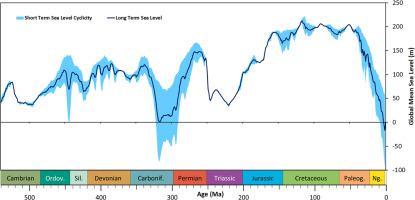Earth and Planetary Science Letters – Volume 667, 1 October 2025, 119526
Highlights
- •
We present the first reconstruction of sea level change during the last 540 million years due to the waxing and waning of the Earth’s polar icecaps.
- •
Long-term reconstructions of sea level fail to capture short-term, high-amplitude fluctuations—especially those driven by glacio-eustasy during icehouse periods.
- •
The study uses a high-resolution Cenozoic climate model and long term Phanerozoic ice volumes to estimate orbital-scale sea level variability over the past 540 million years.
- •
Greenhouse climates like the Jurassic and Cretaceous saw reduced or absent glacial sea level fluctuations, in contrast to short term changes >100 meters during the Paleozoic and Cenozoic.
- •
Sea level estimates during greenhouse periods may have been overstated by stratigraphic methods, or result from other causes than glacio-eustasy.
‘Sea Level Variations’:
‘Phanerozoic Paleotemperature variability’:
Abstract
Global Mean Sea Level, or eustasy, has a strong effect on depositional systems, biogeochemical cycles, and climate along continental margins. Long-term Phanerozoic Tectono-Glacio-Eustatic curves based on isotope geochemistry or plate reconstructions provide first-order trends but cannot resolve short-term (<1 Myr) high amplitude ice volume-forced variability, that resulted in glacio-eustatic fluctuations of >100 m during Paleozoic and Cenozoic icehouse times. These glacio-eustatic fluctuations were minor (∼20 – 40 m) to absent during Mesozoic greenhouse climates. We provide a continuous quantification of maximum amplitude short-term sea level change during the last 540 million years. We utilize a high-resolution Cenozoic climate model to estimate orbital-scale (103-105 years) temperature and ice volume variations as a function of long-term (≥ 1 Myr) changes in ice volume. Building upon a recent long-term ice volume reconstruction, we then calculate maximum feasible orbital-scale cyclicity for the entire Phanerozoic. Our estimates of sea level change during greenhouse climates are much lower than some estimates based on stratigraphically derived eustatic reconstructions. This suggests that these stratigraphic methods overestimate orbital-scale sea level change or that these were caused by other factors such as aquifer eustasy. Our analysis quantifies the range of glacio-eustatic sea level variability that may be used as independent constraint in future paleoclimatologic, paleogeographic, paleontologic, and paleoceanographic research.



